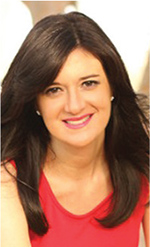
Everyone gets excited about credit union conferences – they'rethe perfect excuse to blend work with play. But how can eventorganizers ensure the play doesn't overshadow the work (and viceversa)?
|Having been to credit union conferences in various cities overthe years – Portland, Ore.; Seattle; San Diego; Tucson, Ariz.;Washington and Montreal to name a few – and having just returnedfrom CU Direct's Drive in Las Vegas last week, I got to thinkingabout what makes a conference worth the hefty registration fee.
|I asked Drive attendees for their honest opinions on thatconference, and their responses were 100% positive, both on theevent itself and the material presented. Granted, the location –The Cosmopolitan of Las Vegas – and resources available there madethe event nothing short of spectacular. There were aerialperformers in the exhibit hall during the receptions, for cryingout loud. Plus, the fact attendees could find everything theyneeded within the same building, including restaurants, bars, shopsand the conference itself, upped the convenience factor.
|Not every conference planner has the luxury of injecting thatkind of luxury into their event, still, they can all apply thesepointers to boost attendance, create a memorable experience andensure attendees bring something of benefit back to their creditunion.
|An app is where it's at. One of my biggest “wow” momentsat Drive was after I downloaded the social networking app createdspecifically for the event. The app allowed attendees to create aprofile, view a list of attendees and message them personally, postupdates to a feed, view the agenda (plus create a personalizedagenda with sessions they plan to attend) and receive notificationsabout event happenings. And a detailed map helped keep attendeesfrom wandering around aimlessly. This is a kick-a** tool thatsolves common problems for conference-goers and fosters socialconnections, and every conference planner should consider offeringone.
|Think location, location, location. Many conferenceattendees see the event as not just a mandatory work event, but achance to travel somewhere they've never visited, explore the areaand take a break from their usual routine. So naturally, aconference in a sexy location – like The Cosmopolitan in Vegas – isgoing to result in higher attendance than one at a Marriott inOmaha, Neb., unless the primary goal is cost savings. However, alocation that's too nice might defeat the purpose of the event. Ifthe conference is hosted in Hawaii, for example, who can reallyfocus their full attention on work when a beachside Mai Tai or hikeup Diamond Head is calling? And places with tempting nightlifeoptions, like Vegas or New York City, might translate to sleepyattendees or morning session skippers.
|A winning location is a midsized city that still hasvacation-worthy appeal – a place that offers unique activities plusallows travelers to stay within budget. According to the post “TheBest Cities for Conferences in 2016” on SmartAsset.com, Texas livesup to its big-ego stereotype in the conference world – three citiesin Texas made the top 10. San Antonio took the No. 1 spot on thelist, followed by El Paso, Texas; San Diego; Austin, Texas; Irving,Texas; Columbus, Ohio; Orlando; Albuquerque, N.M.; and Charlotte,N.C.
|Provide real session takeaways. Like at most conferences,Drive's agenda included carefully-selected speakers and topics thataddressed common challenges faced by credit union leaders. Onesession, for example, included solid takeaways on branchtransformation best practices, and another on cybersecurityfeatured a retired FBI special agent. But even when sessions areled by the most engaging speakers, how can you ensure attendeeswill actually use the information they gather at their creditunion?
|
You don't want to give attendees a pile of tedious work (they'resemi-“on vacation” after all), but incorporating an activity intoeach session that makes them think can boost their chances ofbringing real ideas back home. During one session at the FileneResearch Institute's “big. bright. minds.” conference in 2014, forexample, we split into groups and brainstormed ideas for newfinancial products that could support the latest consumer lifestyletrends, like multigenerational households.
|The activity could be something simple like turning to yoursession neighbor, telling them about your biggest on-the-jobchallenge in the past month and asking them how they would havehandled it. Or, give each session attendee a task for when theyreturn to the office and have them email the group to let them knowhow it went.
|Burst open social bubbles. When they arrive, conferenceattendees might have big goals for going home with a huge stack ofbusiness cards belonging to potential new collaboration partners,employees and friends from across the nation, only to stay mostlyglued to folks from their own credit union during sessions,receptions and dinners. Conference organizers can break this cycleby planning activities that force attendees to interact with peopleoutside their immediate circles. The post “9 Ways to EncourageNetworking at Your Event” on Converve.com offered thesesuggestions:
Plan an activity that gets people talking in a speed dating-likeformat, or schedule a competition, contest or scavenger hunt.
In longer sessions, assign attendees to two different tables –one for the first half of the session and another for the secondhalf – to expose them to new faces.
Choose venues that are large enough to allow for a flow of foottraffic and include strategically-placed congregation areas thatencourage conversation, like cocktail tables and waterstations.
To keep people from dining alone at the hotel bar, offer a“dinner with strangers” program. Provide sign-up sheets eachmorning with information about restaurants, reservation times andtransportation arrangements.
Remember, even if conference organizers fall short in planningthe perfect event, you can be proactive in maximizing your time asan attendee. Come prepared, make it a goal to meet at least one newperson in each session or activity, and pick a useful takeaway toincorporate into your job back home. Happy conference travel!
Complete your profile to continue reading and get FREE access to CUTimes.com, part of your ALM digital membership.
Your access to unlimited CUTimes.com content isn’t changing.
Once you are an ALM digital member, you’ll receive:
- Critical CUTimes.com information including comprehensive product and service provider listings via the Marketplace Directory, CU Careers, resources from industry leaders, webcasts, and breaking news, analysis and more with our informative Newsletters.
- Exclusive discounts on ALM and CU Times events.
- Access to other award-winning ALM websites including Law.com and GlobeSt.com.
Already have an account? Sign In
© 2024 ALM Global, LLC, All Rights Reserved. Request academic re-use from www.copyright.com. All other uses, submit a request to [email protected]. For more information visit Asset & Logo Licensing.









